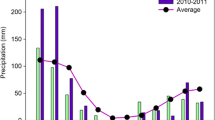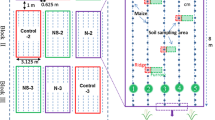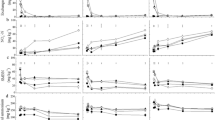Abstract
The organic materials of vetch straw, isotopically labeled with15N and unlabeled, rice straw and15N-enriched urea were applied to rice in a greenhouse experiment to evaluate the release of available N during the decomposition of vetch material and its uptake by rice, and to measure the effect of organic materials on the efficiency of urea-N utilization by rice. Measurements were made at three sampling stages during the growth period. As expected, vetch material decomposed readily and furnished a continuous supply of N for the growth of rice, although only 18.1% of vetch-N was utilized by the rice crop. However, this was not sufficient to support the survival of all tillers until harvest. After harvest, 70% of vetch-N still remained in paddy soil. The influence of organic materials on urea-N absorption by rice became apparent at about the stage of panicle initiation. The highest urea-N uptake by rice was 42.2% in vetch straw-mixed soil. Otherwise, rice straw retarded urea-N uptake by rice. Nitrogen distribution data indicated that the vetch material would stimulate urea-N uptake by rice plants.
The residual effect of vetch material was evaluated by planting Sudan grass immediately after rice was harvested. Only 4.4% of residual vetch-N was utilized in 20 weeks. This low percentage of N uptake and its low availability ratio demonstrated the poor residual effects of this leguminous material.
Similar content being viewed by others
References
Bhardwaj KKR and Dev SP (1985) Production and decomposition of Sesbania cannabina (Retz.) Pers. in relation to its effect on the yield of wetland rice. Tropical agric 62: 233–236.
Bhardwaj SP, Prasad SN and Singh G (1981) Economizing nitrogen by green manure in rice-wheat rotation. Indian J Agr Sci 51: 86–90.
Bin J (1983) Utilization of green manure for raising soil fertility in China. Soil Sci 135: 65–69.
Bower CA (1951) Availability of ammonium fixed in difficulty exchangeable form by soils of semiarid regions. Soil Sci Soc Amer Proc 15: 119–122.
Broadbent FE and Nakashima T (1967) Reversion of fertilizer nitrogen in soils. Soil Sci Soc Amer Proc 31: 648–652.
Broadbent FE and Nakashima T (1970) Nitrogen immobilization in flooded soils. Soil Sci Soc Amer Proc 34: 218–221.
Cheng HH and Bremner JM (1966) Denitrification and isotope ratio analysis of different forms of nitrogen in soil. 2, A simplified procedure for isotope-ratio analysis of soil nitrogen. Soil Sci Soc Amer Proc 30: 450–452.
Huang DM, Gao JH and Zhu PL (1981) The transformation and distribution of organic and inorganic fertilizer in rice-soil system. Acta Pedologica Sinica 18: 107–121.
Ladd JN, Amato M and Oades JM (1985) Decomposition of plant material in Australian soils. III. Residual organic and microbial biomass C and N from isotope-labelled legume material and soil organic matter, decomposing under field conditions. Aust J Soil Res 23: 603–611.
Lynch JM and Harper SHT (1985) The microbial upgrading of straw for agricultural use. Philosophical Transactions of the Royal Society of London Ser. B 310: 221–226.
Nagarajah S and Amarasiri SL (1977) Use of organic materials as fertilizers for lowland rice in Srilanka. In: Soil Organic Matter Studies. Proceedings of a Symposium organized by IAEA, FAO and Agrochimica Braunschweig, September 1976. Vol I Vienna, Austria; International Atomic Energy Agency (1977) 97–104.
Savant NK and De Datta SK (1982) Nitrogen transformations in wetland rice soils. Adv Agron 35: 241–302.
Till AR, Blair GJ and Dalal RC (1982) Isotopic studies of the recycling of carbon, nitrogen, sulfur and phosphorus from plant material. In: Cycling of Carbon, Nitrogen, Sulfur and Phosphorus in Terrestrial and Aquatic Ecosystems, 51–59. Edited by Freney JR and Galbally IE, Berlin, Germany. Springer-Verlag.
Weeraratna CS (1979) Pattern of nitrogen release during decomposition of some green manure in a tropical alluvial soil. Plant and Soil 53: 287–294.
Yoshida T and Pardre BC Jr (1975) Effect of fertilizer nitrogen in a Philippine soil. Soil Sci Plant Nutr 21: 281–292.
Author information
Authors and Affiliations
Rights and permissions
About this article
Cite this article
Huang, ZW., Broadbent, F.E. The influences of organic residues on utilization of urea N by rice. Fertilizer Research 18, 213–220 (1988). https://doi.org/10.1007/BF01049571
Received:
Accepted:
Issue Date:
DOI: https://doi.org/10.1007/BF01049571




